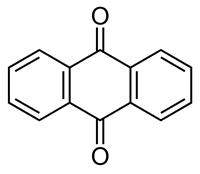Anthraquinone
Anthraquinone is the class-defining compound for a number of naturally-occurring plant pigments. Anthraquinone itself has been associated with causing liver, bladder and kidney cancers, and other non-neoplastic disorders.[1]. It also, however, has been a starting point for developing antineoplastic agents, especially the anthracycline agents, of which doxorubricin (Adriamycin) is best known. [2]
The plant Rheum palmatum, called Indian rhubarb in North America and also used in traditional Chinese medicine is rich in anthraquinones. Indian rhubarb is a constituent of the herbal cancer treatment, Essiac. Extracts of the plant have shown activity against hepatitis B virus.[3]
Aloe-emodin (1,8-dihydroxy-3-(hydroxymethyl)-anthraquinone) is an active component from the root and rhizome of R. palmatum. Activation of caspase-3, caspase-8, and caspase-9 is an important determinant of apoptotic death induced by aloe-emodin. These results suggest that aloe-emodin induces cell death in a human lung squamous cell carcinoma line, CH27, by the Bax and Fas death pathway.[4]
References
- ↑ TR-494 Anthraquinone, National Toxicology Program, U.S. Department of Health and Human Services
- ↑ Lown JW (1993 Nov), "(Abstract) Anthracycline and anthraquinone anticancer agents: current status and recent developments.", Pharmacol Ther 60 (2): 185-214
- ↑ Li Z; Li LJ; Sun Y; Li J (2007), "(Abstract) Identification of natural compounds with anti-hepatitis B virus activity from Rheum palmatum L. ethanol extract.", Chemotherapy 53 (5): 320-6
- ↑ Lee HZ; Hsu SL; Liu MC; Wu CH (2001), "(Abstract) Effects and mechanisms of aloe-emodin on cell death in human lung squamous cell carcinoma", Eur J Pharmacol 431 (3): 287-95
